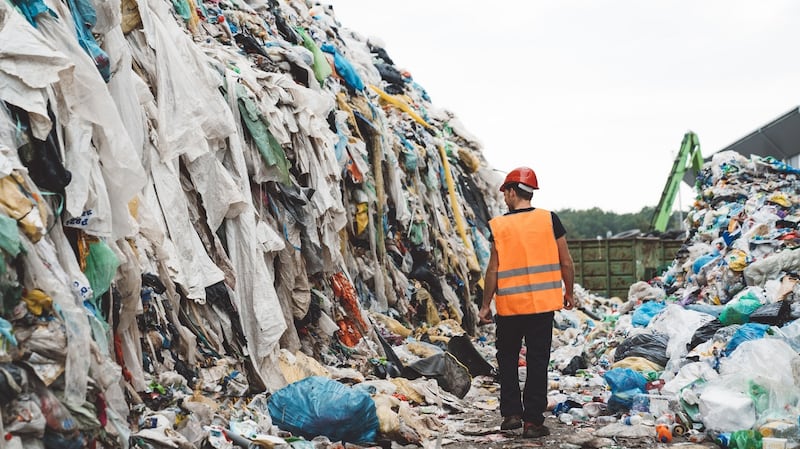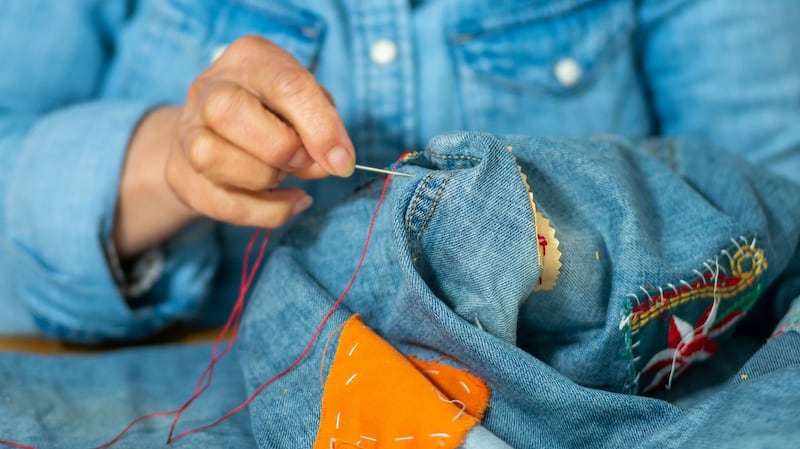There is a rip in the armpit of Orsola de Castro's jumper. She raises her hand high in the air so I can see it: a slash of pale skin peeks from tomato-red wool. This "memory hole", as De Castro describes it, tells the story of the jumper's long life. It was owned by her cousin, then her daughter. "It is very old Benetton, from when Benetton was still made in Italy. You can't see it on Zoom, but this is really nice wool," she says, arm still aloft.
The 54-year-old is an activist, lecturer, former designer and cofounder of the not-for-profit movement Fashion Revolution. With the publication of her book Loved Clothes Last, she has also become a kind of anti-Marie Kondo. She advocates “radical keeping”, not decluttering. “The only antidote to throwaway culture is to keep. So I am an obsessive keeper,” she says.
Her book is full of startling facts about fashion’s impact on the planet and its people. It is “as much about mending systems as mending clothing”, says De Castro.
Some people love rescuing pets. I started off rescuing clothes – and have never stopped. There is a purpose. It is not just aesthetic, it is also profoundly moral in many ways
De Castro grew up in Rome. She moved to London at 16, did her A-levels, then had the first of her four children at 18. She made clothes for years, first with a small line of upcycled hats, then printed textiles.
Mainstream fashion attention came in 1997 when she founded the brand From Somewhere, which specialised in salvaging knitwear others deemed irreparable. Liv Tyler and Nicole Kidman were among the fans of her decaying cashmere cardigans decorated with tightly crocheted stitching.
“Some people love rescuing pets. I started off rescuing clothes – and have never stopped,” she says. Her design process was initially creative, not ethically driven. A eureka moment came while she was “climbing mountains of rubbish in a warehouse” to source holey jumpers. “I thought: ‘Okay, I am not just designing – I am recuperating,’” she says. “There is a purpose. It is not just aesthetic, it is also profoundly moral in many ways.”
De Castro and Carry Somers, a former Estethica designer, founded Fashion Revolution in 2013, after the Rana Plaza disaster in Bangladesh, in which 1,135 people died when a textile-factory complex collapsed. De Castro calls it "the worst 'I told you so' ever".
Fashion Revolution now has a presence in 92 countries. It is growing alongside mainstream awareness of the climate crisis and the inequities of global capitalism. In fashion, sustainability is finally de rigueur, at least on the surface. However, the horror stories that have emerged during the Covid-19 pandemic – allegations of Pakistani workers earning little more than 30c an hour while making clothes for companies including Boohoo; garment makers in developing countries facing homelessness and hunger as brands cancel orders – have demonstrated that injustices remain deeply ingrained.
De Castro sees parallels between Rana Plaza and Covid: “It has highlighted the horrendousness, so I think there is a chance for many of the real issues around sustainability to be tackled. We’ve got a moment in time in which to operate before, unfortunately, we will forget about it again.”
Developing a long-term mindset is one way to be part of the movement. Here, she explains how to do it.
Be careful what you buy in the first place
"Your first habit should be turning your clothes inside out and reading the label," says De Castro. Learning a bit about fabrics can be useful. For example, "polyester sheds millions of microfibres", she says. "It has been found in the bottom of the ocean and the top of Everest. Every time you wash a piece of polyester, about 500,000 microfibres are released. So, how do you buy polyester? You buy something that doesn't need to be frequently washed. You don't buy polyester underpants; you buy a polyester overcoat that you can learn how to sponge-clean."
Wash less often
Overwashing can send garments to an early grave. "Before the washing machine, washing was really arduous and laborious," she says. "Women would do anything not to have to wash the family's clothes and the level of invention of how to delay that wash is, in itself, literature. So brilliant: all the sponging, spot-cleaning, putting in the sun to bleach."
Many of these techniques, De Castro says, are easier than you might think: “The majority of stains can be removed with a quick damp sponging.” She also advocates thoroughly sniff-testing a worn garment and putting it back on the shelf whenever possible. Examining washing instructions is important, too. “We all used to know that you can wash cotton, but wool will shrink. It’s a wisdom that we had and have lost – and need again.”
This is just as important for fast fashion as designer clothing, says De Castro, because price is not always an indicator of longevity. In her experience, a robustly made bra from the high street is likely to outlast most delicate, lacy designer underwear – if treated properly. However posh your pants are, she recommends retaining some of the water after a bath or a shower and hand-washing them.
Reframe decluttering

De Castro's favourite quote is: "Nothing is created and nothing is destroyed, but everything is transformed," attributed to Antoine Lavoisier, one of the progenitors of modern chemistry. "The fact that there is no 'away' is a chemical truth, not an activism ruse," she says. "For every clear-out, stuff goes into landfill or into an incinerator." These landfills, she says, are often in countries "where regulations are way less stringent and therefore toxic materials are likely to decompose in a more harmful way. Often, decluttering yourself means cluttering up someone else's life or land."
Try a moth decoy
Keep a sacrificial lamb – an old jumper or a ball of yarn in a fabric that moths will love – that can get chewed in your wardrobe while other knits remain intact. You will need to experiment on fabric, De Castro says. "I don't know if moths are regional, but camel wool does it for my moths. Shetland is another one – woo, do they love Shetland! I feed my moths like I feed my cats."
Hide your clothes
"I have a game I play with myself. I hide things from myself for a long time. I put them in a bag and put it under the bed," says De Castro. "I hide things that are not right for me, whether that's because your body changes, your mind changes or trends change."
She says that, when she opens them, after about five years, she often loves them “beyond description”. “Two years ago, I rediscovered a skirt – I could never remember hiding it in the first place. Now I wear it incessantly.”
Embellish your imperfections

De Castro is keen on “pareidolia” – spotting faces and shapes in clouds, stones and other objects. She does it with stains. When her children were little, they would find a shape in the stains on their clothing and “draw” around them, creating patterns with embroidery.
Another tactic is to hide stains and holes creatively using brooches. “I always have two or three in my handbag. In case of a stain, I can cover it up temporarily.” She has one jacket that looks “military-like” with its rows of brooches covering moth-chewed lapels. “It gives me so much confidence. I feel like a properly decorated human when I wear it.”
In her book, she advocates boro, the Japanese art of mending denim, by which layers of fabric scraps are used as patches and affixed with visible stitches. This is not because she is an expert (she does not own a pair of jeans and points to the extensive tutorials on YouTube), but because “the first time I saw a pair of boro jeans I thought, Oh, that looks like distressed denim, and the connection was immediate”. She wonders why people buy distressed jeans – particularly when the process of distressing them artificially is often terrible for the planet – when you can live in them instead and appreciate their elegant decay.
Don't upcycle
It is tempting to think that we can transform our wardrobes by upcycling, but De Castro warns against it. Amateur upcycling, she says, often generates more waste. Unless you are happy making mistakes while you learn complex techniques, her suggestion is "do what you can do well, but otherwise I am an absolute believer that people should do their job".
If you don’t have the skills, but you do have upcycling fodder in your wardrobe – “Perhaps two of your mother’s evening gowns that don’t suit your taste or style; how about you put them together and redesign them into something?” – she advises seeking out fashion students or local tailors to bring a new garment to life.
Rethink donating to a charity shop

Most charity shops are nowhere near able to sell the glut of donations. Many items of clothing are shipped abroad, she says: "Often to Africa or Haiti or eastern Europe, where textile skills have been lost because of too much of our rubbish... We're not donating, we're dumping."
She urges exploring other avenues first. Her preference is giving items to friends and family who will wear them. If you donate, “think of it as though you are selling something. Pick up a broken hem or clean and polish your shoes, bearing in mind that you should only donate something the charity will be able to profit from. You have to be really competitive with yourself. Think: ‘I want to see that in the window!’” Lesser-quality textiles could be cut up for use as kitchen rags or taken to a textile recycling bank.
Normalise mending – at all price points

Buying natural fibres and robustly-made clothing is financially difficult for many people, while the time-poor may balk at the idea of trawling charity shops, spot-cleaning and sewing. Nonetheless, De Castro insists that her longevity manifesto is all-encompassing: “The idea that cheap fashion doesn’t warrant mending is horrendous.
“It is precisely people of limited economic or time means for whom longevity should have been invented,” she says.
Her ardent wish is that repairing – already on offer from some brands, such as Toast, but often at a price that is out of reach of most – goes mainstream. She imagines a world in which there are repair stations in shops from Tesco to Penneys. This would help busy people and also mean that “we would see and understand the culture of repair”.
One thing that can be done is writing to governments and companies to request such innovations. "100 per cent of the population wears clothes, so we have a responsibility as consumers, but brands and governments have an obligation to make it as sustainable as possible," she says. "We need societal intervention from the brands that have already made such a fortune on us – it's give-back time." – Guardian
Loved Clothes Last by Orsola de Castro is published by Penguin Life


















